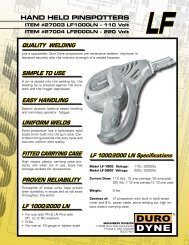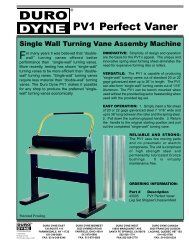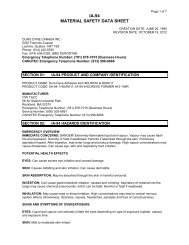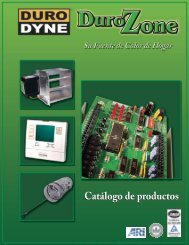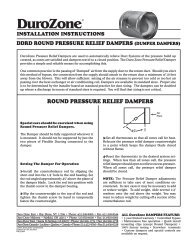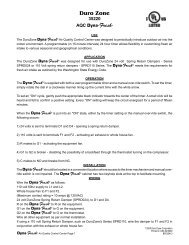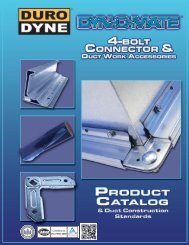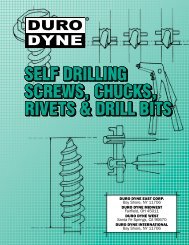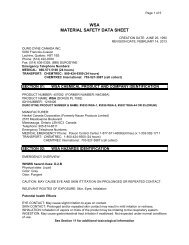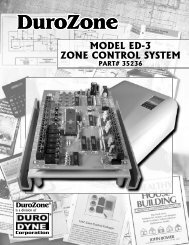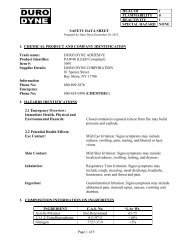Dyna-Stud Installation Instructions - Duro Dyne
Dyna-Stud Installation Instructions - Duro Dyne
Dyna-Stud Installation Instructions - Duro Dyne
Create successful ePaper yourself
Turn your PDF publications into a flip-book with our unique Google optimized e-Paper software.
®<br />
<br />
<strong>Dyna</strong>-<strong>Stud</strong><br />
<strong>Installation</strong> <strong>Instructions</strong><br />
Step 1: Insert and tighten<br />
the <strong>Dyna</strong>-<strong>Stud</strong> into a<br />
threaded receptacle of the<br />
corresponding size (see chart<br />
at right). A locking jam nut<br />
is recommended to prevent<br />
the <strong>Dyna</strong>-<strong>Stud</strong> from turning.<br />
Step 2: Using the appropriate<br />
cable lock (see the<br />
chart at right), pull adjustment<br />
pin back and pass the<br />
end of the wire rope through<br />
the <strong>Dyna</strong>-Tite Cable Lock.<br />
Step 3: Loop the wire rope<br />
around the ductwork and back<br />
up through the Cable Lock.<br />
Item #<br />
Code<br />
Thread<br />
Size<br />
Cable<br />
Lock<br />
*Safe<br />
Working Load<br />
30062 DSA1405-332 1/4 - 20 CL12 25-150<br />
30063 DSA1410-332 1/4 - 20 CL12 25-150<br />
30064 DSA1415-332 1/4 - 20 CL12 25-150<br />
30065 DSA1425-332 1/4 - 20 CL12 25-150<br />
30066 DSA3805-18 3/8 - 16 CL18 25-225<br />
30067 DSA3810-18 3/8 - 16 CL18 25-225<br />
30068 DSA3815-18 3/8 - 16 CL18 25-225<br />
30069 DSA3825-18 3/8 - 16 CL18 25-225<br />
*Safe Working Loads are based on a 5:1 Safety Factor.<br />
DO NOT EXCEED THE SAFE<br />
WORKING LOAD OF THE PRODUCT<br />
IMPORTANT: TO ENSURE THE INTEGRITY OF THE<br />
DURO DYNE CABLE LOCK SYSTEM,<br />
USE THE CABLE LOCK ONLY WITH WIRE ROPE<br />
SUPPLIED BY DURO DYNE CORPORATION.<br />
DO NOT USE FOR LOADS OUTSIDE THE STATED RANGE OF THE PRODUCT<br />
DO NOT EXCEED THE SAFE WORKING LOAD OF THE PRODUCT<br />
REMOVE DAMAGED CABLE END PRIOR TO INSERTING INTO THE CABLE LOCK<br />
KEEP THE PRODUCT CLEAN AND FREE FROM DIRT<br />
DO NOT APPLY LUBRICANT DO NOT USE ON COATED WIRE ROPE<br />
DO NOT APPLY PAINT OR OTHER COATING<br />
DO NOT USE FOR LIFTING OR DYNAMIC LOADS<br />
DO NOT USE IN CHLORINATED ATMOSPHERES<br />
FOR DRY LOCATIONS ONLY<br />
81 Spence Street • Bay Shore, NY 11706 • Tel: 631-249-9000 • Fax: 631-249-8346
®<br />
Drop-In<br />
<strong>Installation</strong> <strong>Instructions</strong><br />
<br />
The drop in anchor is a female anchor designed for use in solid concrete only and can't be used in brick or block material.<br />
The anchor size is designated by the inside diameter of the anchor. The diameter of the hole to be drilled is the same size as the<br />
outside diameter of the anchor. When fastening to solid concrete with a drop in anchor, a hole must be drilled into the base material.<br />
CAUTION<br />
Before<br />
starting<br />
to drill the<br />
hole, it is<br />
important<br />
that eye<br />
and ear<br />
protection<br />
are used.<br />
Step 1: Insert a carbide<br />
tip masonry bit<br />
into the hammer-drill<br />
chuck and tighten it in<br />
place. The depth of<br />
the hole to be drilled<br />
can easily be set by<br />
using the depth gauge<br />
on the drill or by wrapping<br />
the bit with tape<br />
at the required depth.<br />
Make sure that the<br />
hole depth will allow<br />
the anchor to be flush<br />
with the surface of the<br />
concrete.<br />
Step 2: Make sure<br />
the hammer drill<br />
is in the hammer<br />
mode and start<br />
drilling your hole.<br />
Continue drilling<br />
until the tape on<br />
the bit or the drill<br />
gauge meets the<br />
base material-this<br />
means that the<br />
required depth has<br />
been reached.<br />
Step 3: Before<br />
proceeding with<br />
installation, the hole<br />
must be cleaned<br />
of all concrete<br />
dust to ensure<br />
proper fastening.<br />
Use a wire brush,<br />
a vacuum or<br />
compressed air to<br />
clean out the hole<br />
completely.<br />
Step 4: Next, insert<br />
the drop-in anchor<br />
with the open side<br />
up. Drop the anchor<br />
into the hole. Tap<br />
lightly to get the<br />
anchor flush with<br />
the base material.<br />
Step 5: Now,<br />
take the setting<br />
tool and insert it<br />
into the anchor.<br />
Strike the setting<br />
tool with a<br />
hammer until the<br />
lip of the anchor<br />
touches the lip of<br />
the setting tool.<br />
This will ensure<br />
the anchor is<br />
properly set.<br />
81 Spence Street • Bay Shore, NY 11706 • Tel: 631-249-9000 • Fax: 631-249-8346<br />
4/2015



